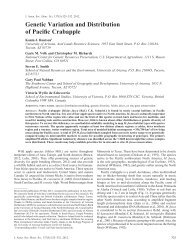CONSERVATION
Conservation You Can Taste - The Southwest Center - University of ...
Conservation You Can Taste - The Southwest Center - University of ...
- No tags were found...
You also want an ePaper? Increase the reach of your titles
YUMPU automatically turns print PDFs into web optimized ePapers that Google loves.
more cost-effective to subsidize their access to these foods rather than pay rising health<br />
costs later as a result of the absence of such foods in the diet.<br />
5. Citizen scientists can be organized at the neighborhood, community or regional<br />
scale can help to observe the conditions under which these heritage foods grow best; we<br />
need to build a community of “amateur experts”: who exchange their insights regarding<br />
how to best propagate, breed, manage, harvest, process, store and utilize these foods.<br />
6. As the recovery and production of a heritage food ramps up, it will be important<br />
for a community to plan and invest in milling or processing facilities, storage facilities<br />
and food distribution hubs that allow these foods to move through short but efficient<br />
supply chains.<br />
7. It is critical to seek out mentors, specialists and technicians who have helped recover<br />
similar heritage foods so that we do not reinvent the wheel each time. They can<br />
help you develop a grow-out toolkit as Chefs Collaborative did following its 2009 and<br />
2010 grow-outs in New England that guided farmers, gardeners in how to best meet<br />
the horticultural needs of rare heritage plants and to form partnerships with chefs and<br />
farmers markets necessary to bring these varieties to the marketplace.<br />
8. It is also worthwhile to develop tasting protocols as American Livestock Conservancy<br />
and the Slow Food Ark of Taste Committee have done to provide a vocabulary<br />
for describing, evaluating and ranking a foodstuff’s flavors, fragrances and textures,<br />
and for exploring its best culinary uses.<br />
9. While avoiding price fixing of any kind, it is important for producers, processors<br />
and chefs to share data on the true cost of producing, marketing and using a heritage<br />
food in scarce supply, and to collectively come to an agreement about an acceptable<br />
price range. It is also critical to understand that as supply and demand change<br />
through time, that the collective spread sheet will undoubtedly need reworked.<br />
74



